Bast fibers have been highly regarded for beautiful, durable textiles throughout history and into the modern era. Over the past year, Fibershed’s Lead Process Engineer Nicholas Wenner has been connecting with bast fiber growers, researchers, processors, and artisans to better understand the state of soil to soil systems for these unique plants. This series examines and documents a range of bast fibers, which derive from the tissue in the outer layer of certain plant stems, including those of flax, hemp, nettle, and dogbane. In the plant, the hollow fibers transport dissolved sugars and lend structural support for the stem. In textiles, the fibers provide strength and many other unique properties. As crops, the plants can play a valuable role in crop rotations and provide high yields of both food and fiber with relatively minimal inputs. In this series, we began with updates on flax. We now explore developments with hemp in the Northern California Fibershed.
Written by Nicholas Wenner
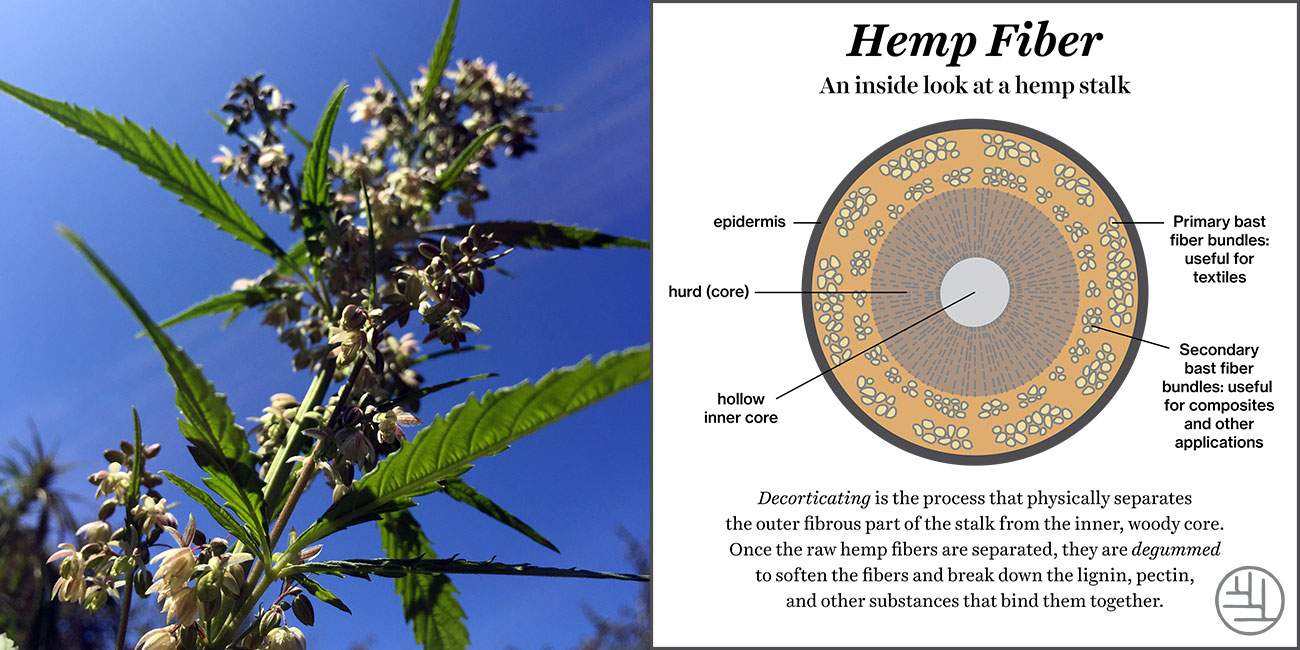
A hemp plant grown in the author’s garden (Photo by Nick Wenner), and an illustrated look at the fibers within.
Encouraged by the Federal legalization of hemp in 2018, Fibershed has continued research into the versatile crop this year, deepening understanding of the plant and the fiber, prototyping hemp textile production in Northern California, supporting agroecological trials, and charting a path forward for weaving hemp into the region.
Humans have bred the plant Cannabis sativa to serve multiple purposes, producing specialized varieties for the production of fiber, seeds, and useful chemical compounds. Plants bred for the production of the psychoactive compound tetrahydrocannabinol (THC) are typically referred to as “cannabis” or “marijuana”, whereas plants bred for fiber, seed, or non-THC products are typically called “hemp” or “industrial hemp.” Specifically, the U.S. Agricultural Act of 2014 defines industrial hemp as “the plant Cannabis sativa L. and any part of such plant, whether growing or not, with a delta-9 tetrahydrocannabinol concentration of not more than 0.3 percent on a dry weight basis.”
Hemp itself has been bred into multiple strains with varying uses: Bushy varieties have been developed for the production of cannabinoids like cannabidiol (CBD), which is harvested from large flowering heads at the ends of abundant branches. Tall, straight varieties have been developed to provide long, continuous fibers along the lengths of their straight stems. Farmers typically sow these fiber varieties much more densely than CBD varieties to encourage tall, thin, unbranched growth among the tightly packed stems. Other varieties specialize in the production of seed or “grain.” Development of “bi-crop” varieties for efficient production of both cannabinoids and fiber is a key area of current development.
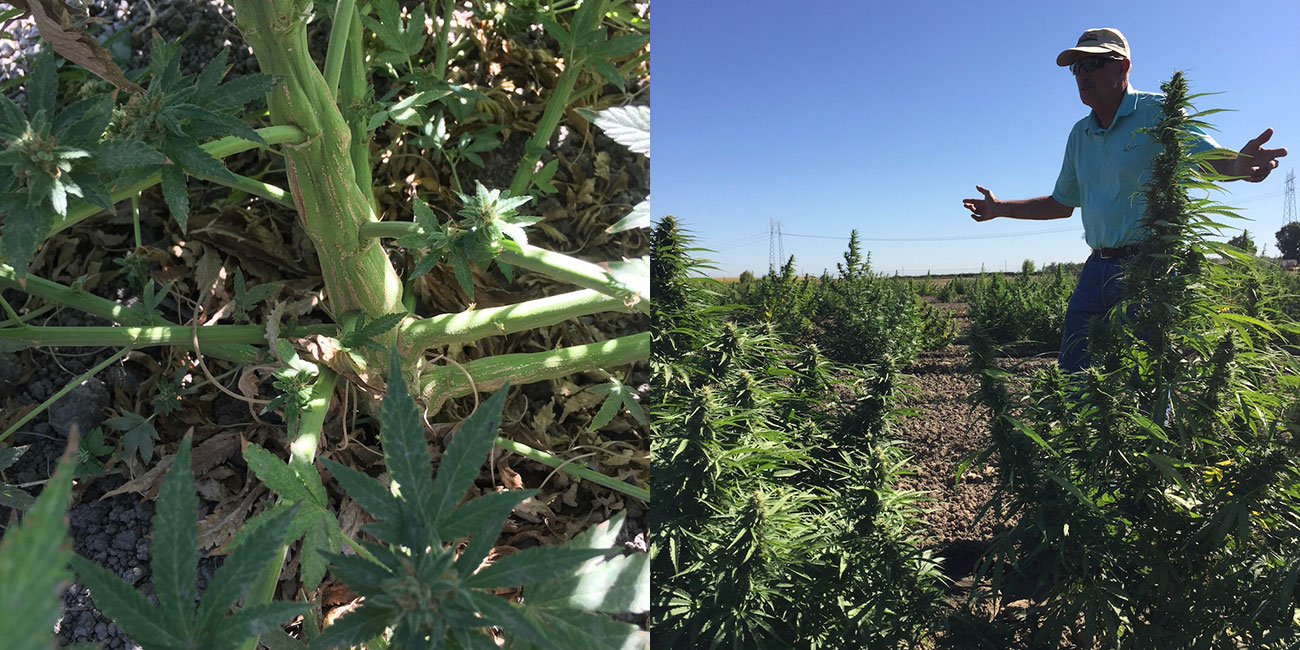
California organic farmer Scott Park grew hemp specialized for CBD production this year on his Sacramento Valley farm. Both the growth habits of the plants and the spacing in the field differ greatly from those of fiber-specific hemp varieties, pictured below. (Photos above by Nick Wenner, photo below from One Acre Exchange in North Carolina)
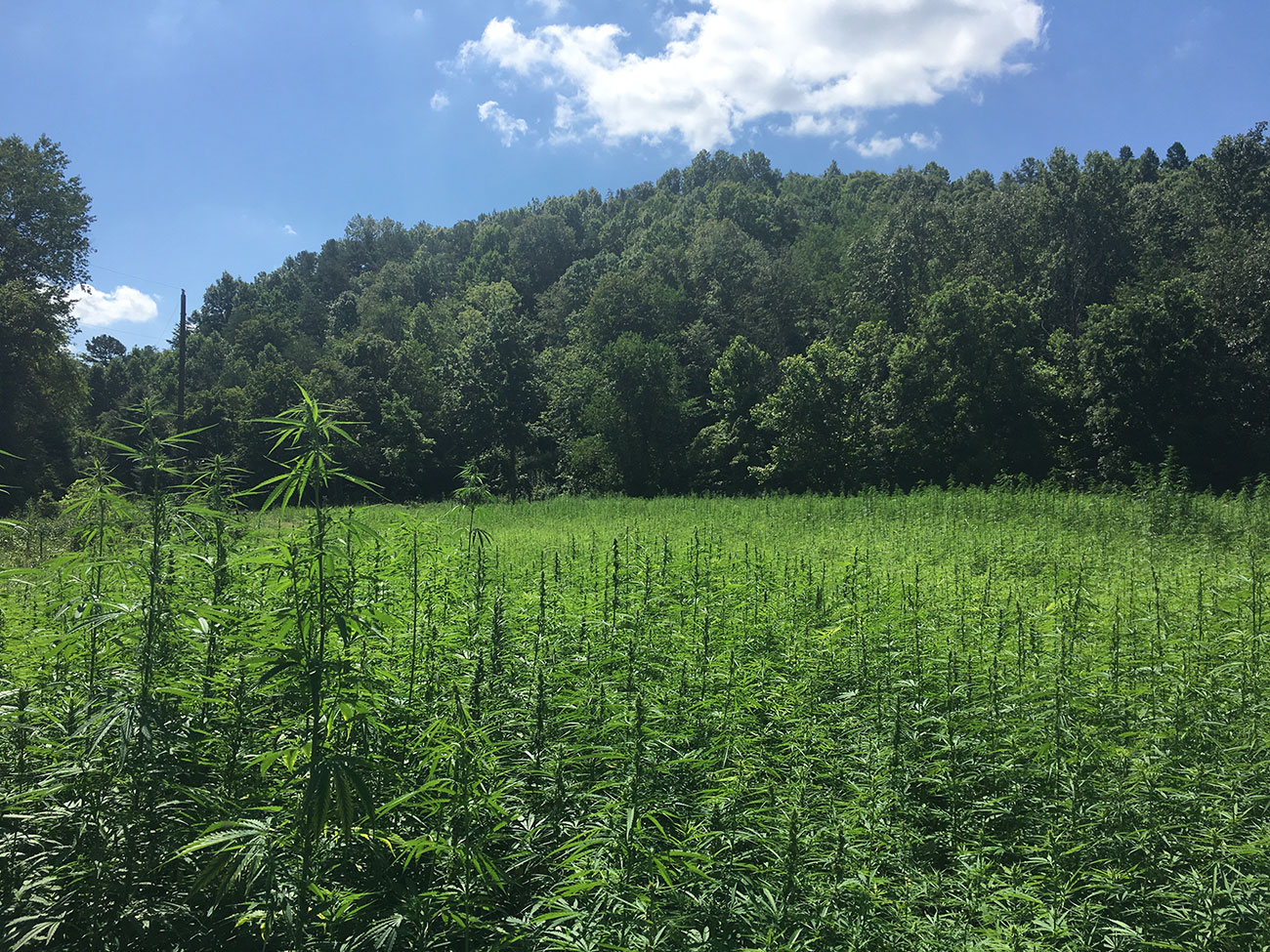
Raw hemp fiber is produced by separating the phloem layer from the inner woody core or “hurd” in the plant stalk. This process is known as decortication. Fiber processors then refine the raw fiber to achieve the fineness and flexibility necessary for textiles.
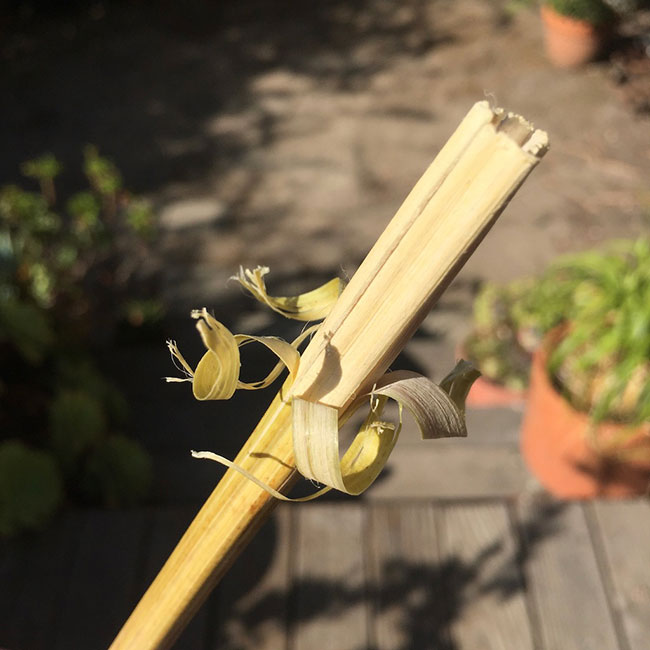
Hemp is a bast fiber, deriving from the phloem in the plant stalk. Here, raw hemp fiber has been peeled away from the inner woody core or “hurd.” The raw fiber must be refined further using a process called degumming to produce fibers suitable for textiles. (Photo by Nick Wenner)
In hemp and other bast fibers, the fibers useful for textiles are packaged within the phloem in bundles of long cells arranged along the length of the stalk. A matrix of lignin, pectin, and other materials binds these fibers together. Individual fibers (or small bundles of fibers) need to be freed from this matrix to produce fibers soft enough for textiles. Various processes employing water, heat, chemical inputs, electrical discharge, and/or microbial action can be used. Collectively, these processes are known as “degumming.” Establishing effective, environmentally responsible, and cost-effective degumming at a commercial scale is a missing link in US hemp manufacturing, and multiple companies—including Bastcore, Circular Systems, and Seff Fibre—are currently working to bridge this gap.
Hemp is noteworthy among bast fibers for containing relatively high levels of lignin and therefore requiring extra effort in the degumming process to produce fibers of a given softness. In general, compared to cotton, hemp fibers are coarse, strong, and low in stretch. Hemp also has the potential for anti-microbial qualities, based on the presence of compounds like alkaloids, flavones, and saponins, many of which serve protective functions in the living plant. These compounds can be removed or deactivated in the degumming step, however, and care must be taken to retain antimicrobial effects in a softened fiber.
Rather than working with short fibers, traditional hemp fiber processing—like traditional linen processing—works with long, intact bundles of fibers that extend as long as the length of the plant. Working with these long fibers requires highly specialized milling equipment that is not currently available in the United States. The majority of the hemp fiber produced in such traditional systems is suited primarily to rope and cordage, and the portion that is used for textiles is suited best to coarse, hard-wearing fabrics. For example, approximately ⅘ of the hemp fiber produced in well-established systems in Hungary goes to twine and rope while the remaining ⅕ goes to textiles. In that same region, hemp was historically used to produce rope and rough fabrics while flax was used to produce lighter, finer fabrics. (For more information about traditional hemp processing, see the book “Bast and Other Plant Fibres” from Woodhead Publishing in Textiles.)
Many modern degumming processes aim to produce fine fibers from hemp that are more suitable for fine textile production than from traditional processes and that can be spun using existing fiber infrastructure for wool or cotton. In such systems, hemp fibers are “affined” or “cottonized” to resemble cotton or wool, mixed with those fibers, and spun into blended yarns using the relatively mature fiber systems developed for those fibers. At least an equal proportion cotton or wool is typically necessary to carry the hemp through the cotton or wool systems. Blending hemp into yarn can impart some of the qualities of that fiber, including strength and anti-microbial properties, and takes advantage of existing infrastructure.
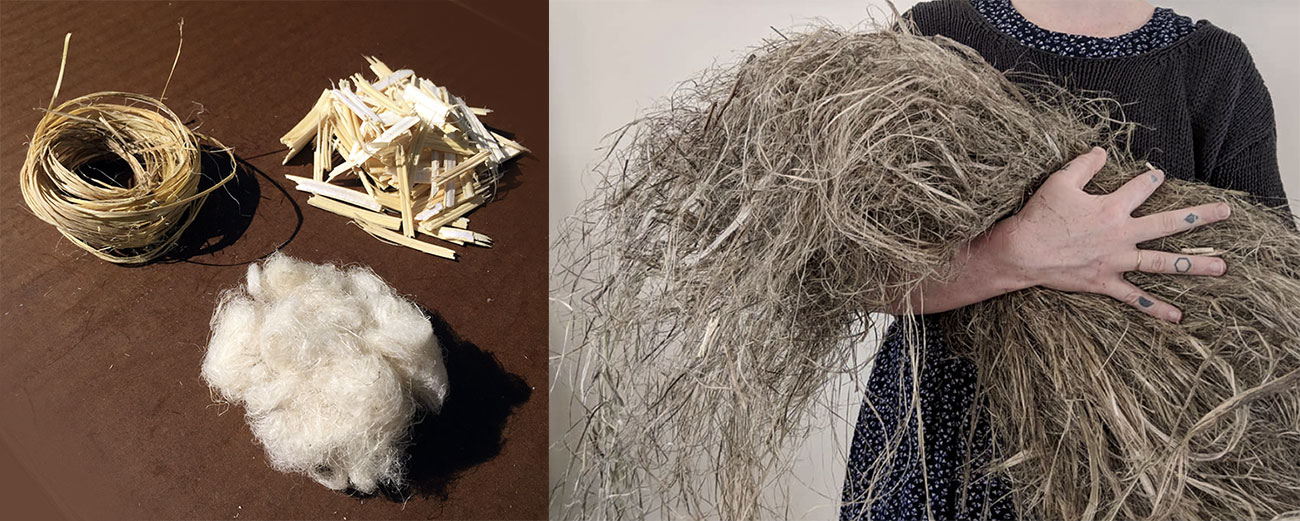
Above left, hemp raw fiber, hurds, and degummed fiber (Photo by Nick Wenner); above right, Katie Berman from North Carolina’s One Acre Exchange project with long hemp fibers processed using traditional methods (Photo from One Acre Exchange)
Prototypes in local milling
Fibershed has been working for multiple years in Kentucky, Minnesota, Colorado, and now California to develop blended hemp textile recipes using existing infrastructure.
For example, in California, the textile infrastructure we already have on the ground is designed for wool, and this year we have been working Mendocino Wool and Fiber Inc. and Valley Oak Wool and Fiber Mill to prototype hemp and wool blends with these existing resources.
Because hemp regulations are still under development and few California farmers grew hemp this year, California hemp fiber was not available for these trials. Given this reality, we sourced hemp fibers from other regions including Minnesota and Canada.
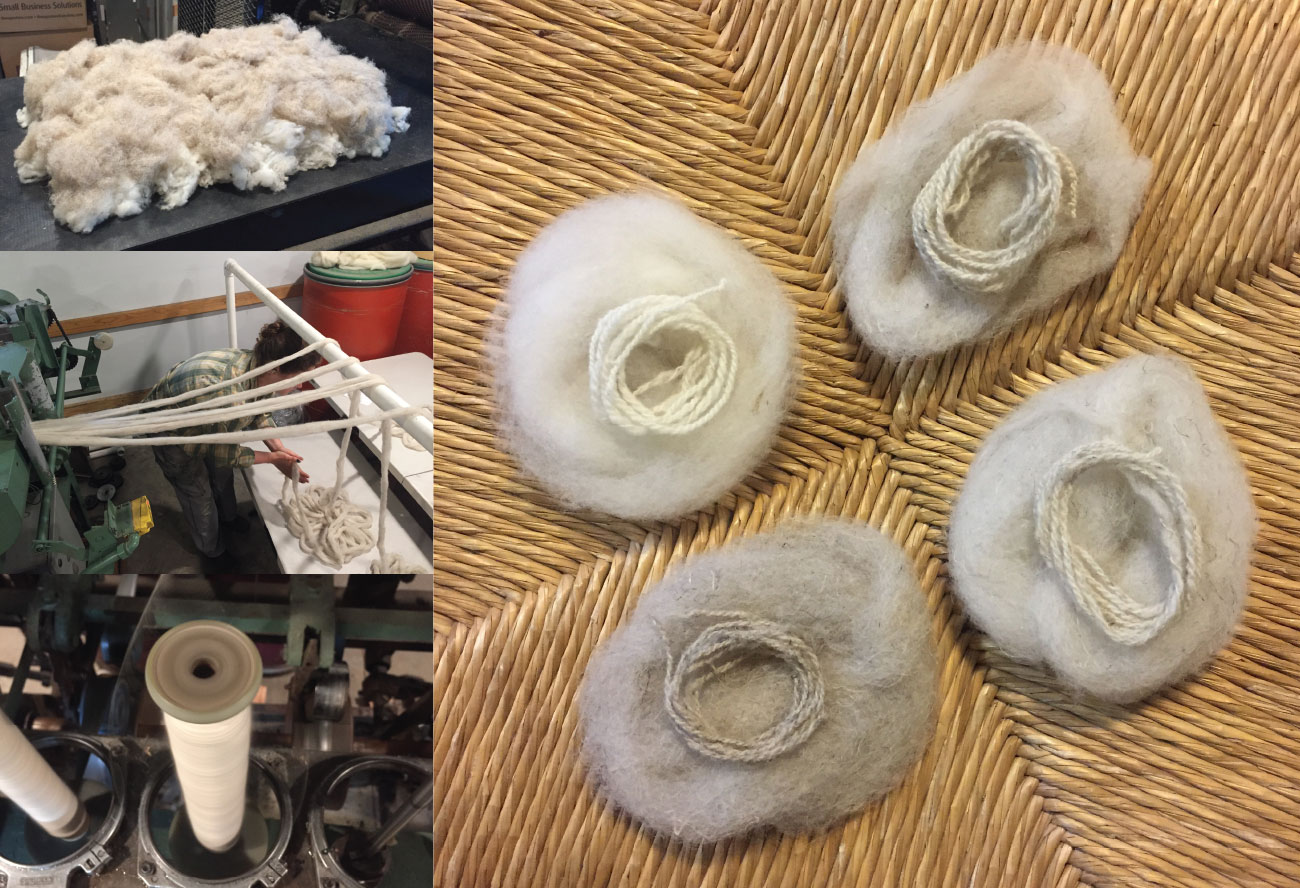
For the first time using local infrastructure, hemp and wool were successfully carded, drafted, and spun into blended yarns. The yarns are both strong and soft to the touch and include 10-90, 25-75, and 50-50 blends of hemp and wool. (Photos by Nick Wenner)
Sarah Gilbert of Mendocino Wool and Fiber Inc. describes the blending process:
Early this spring we were approached by Fibershed to try refining hemp in our wool carder to see how the hemp would react to refinement processes already available in our current supply chain. It took some experimenting with moisture content and speed controls to get the hemp to run on the carder without too much flying away and without running the hemp fibers into dryer lint. Eventually, we figured out how to successfully run the hemp through our carder, making progress with refining the hemp while maintaining fiber integrity. While this was fairly time consuming it gave us a great jumping off point for blending. We decided to blend the hemp with some fine Corriedale wool from Kaos Sheep Outfit that was a good match in texture and staple length for the refined hemp.
We made three different batches of varying blend percentages up to 50% refined hemp. The batches all carded and blended sufficiently well that we decided to proceed to the yarn. We were happily surprised with the results. We made 2-ply yarn from each batch, all the same style yarn, but the differences in each batch were remarkable.
The batch with 10% hemp was less squishy and springy than pure Corriedale yarn tends to be, with more drape than typical of Corriedale yarn, but still a good amount of stretch. The 25% hemp batch was less stretchy with very little squish-factor but still soft. The last batch, at 50% hemp and 50% wool, felt a bit more like paper yarn with a solid structure and no stretch. The drape and stitch definition were really striking. The final batch didn’t blend as thoroughly in the carding and pindrafting stages as the other two blends, and so had a few more slubs in the yarn, but still spun well and had good strength. As we develop a separate, predictable infrastructure to handle the hemp crop before getting to the blending stage I expect that blending will be much more consistent at higher hemp percentages.
Another neat characteristic was how lightweight the yarn felt. The same drape effect in other materials is often paired with a weighty feeling. These blends do not feel heavy at all.
Hemp blends offer us an exciting opportunity to develop biodegradable performance yarns and fabrics, as we look for new ways to eliminate synthetics and utilize local fibers.
This yarn was one of the first products made with the recently commissioned spinning equipment at the Mendocino mill. The yarn was sent to Huston Textile Co., where it was woven into the first local hemp/wool textile produced in recent memory.
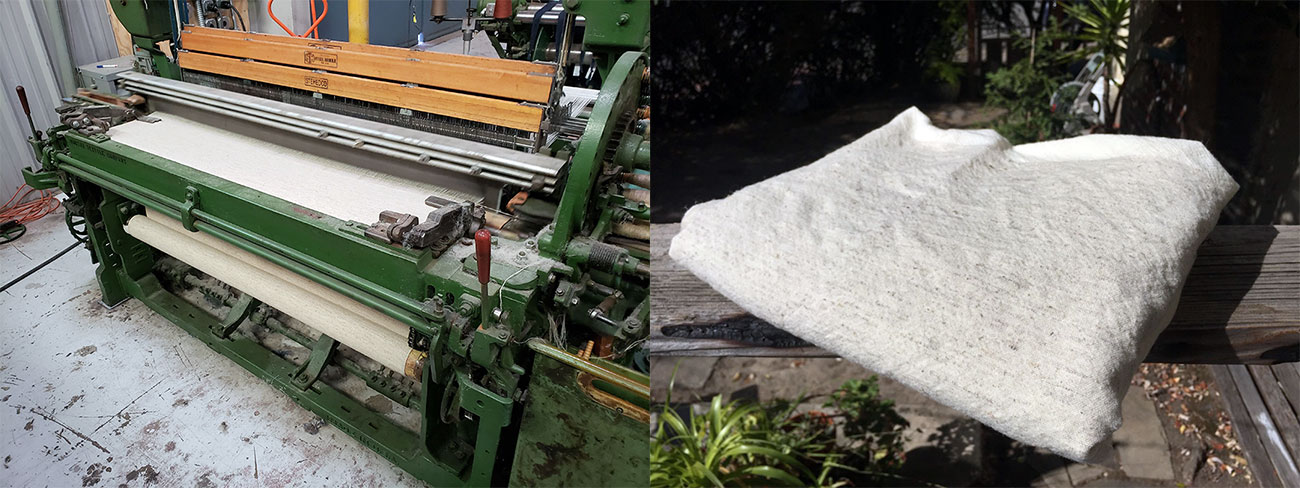
This year Huston Textile Co. and Mendocino Wool and Fiber Inc. produced the Northern California Fibershed’s first woven hemp/wool fabrics in recent memory. (Loom photo by Ryan Huston, fabric photo by Nick Wenner)
The fabric produced tells many stories and embodies a vision for hemp in our fibershed: the hemp was grown and processed by partners in the United States using sustainable practices that can be implemented in California. The wool in the hemp/wool weft yarn comes from Kaos Sheep Outfit, whose sheep graze on public lands for fire fuel load reduction and in mutually beneficial arrangements with California vineyards. The all-wool warp yarns come from Lani’s Lana and is verified as Climate Beneficial™ because of the ranch’s commitment to annual implementation of carbon farming practices on California rangelands. The weft yarn was spun and the fabric woven at family-owned local mills.
The fabric casts a vision for what is possible, and developing it allowed us to prototype production processes already available to us in the region. Due to the relatively early stage of U.S. hemp processing, the hemp fiber we used was somewhat coarse, and this can be felt in the final product. To reach the full potential, we need a local producer of high quality cottonized hemp fiber who employs degumming processes that are technically, ecologically, and economically sound. Fibershed is currently working with multiple partners to realize this vision. Once local degumming has been established, we will have the opportunity to broadly use and refine the hemp/wool “recipes” we developed this year.
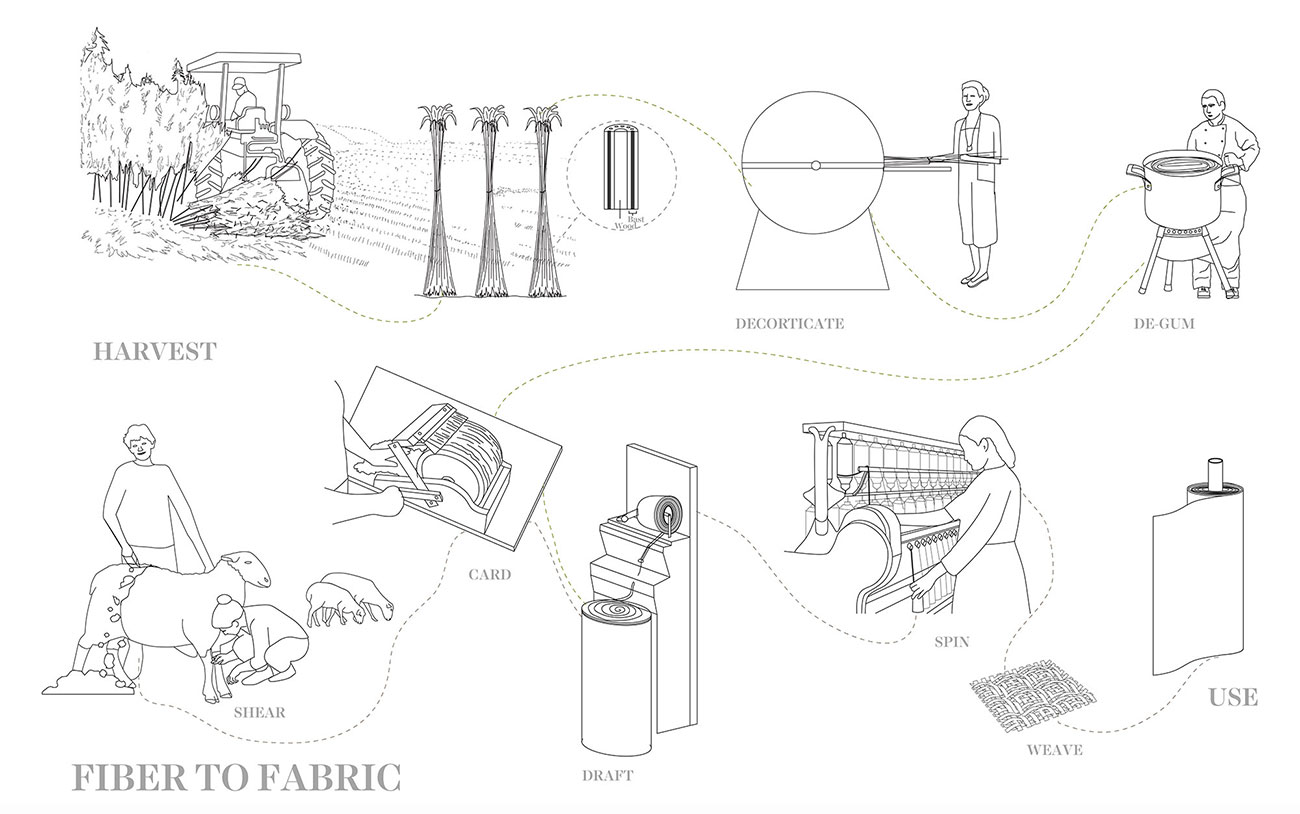
Agroecological trials
While people often claim that hemp requires no pesticides, herbicides, fertilizers, or water, this is true only in very specific contexts. In practice it depends highly on climate, strain, what products are being made, what yields need to be reached for economic viability, and many other factors.
While hemp’s agricultural requirements are relatively low, like any plant it will grow faster if fertilized and competitor plants are suppressed with herbicides. The state departments of agriculture where hemp was first reintroduced routinely recommend herbicides for hemp production, yet we recognize the need to treat hemp – and all of our crops – with more integrated approaches. We see possibilities for creating agroecological systems that engage mutually beneficial relationships with plants, animals, and soil to produce food, fiber, livelihoods, and functioning ecosystems.
Since 2016, Fibershed has supported research at the Rezolana Institute in Colorado’s San Luis Valley to explore these possibilities. In 2018, land manager Arnie Valdez ran field trials involving compost application, rotational grazing, and multi-species intercropping with hemp, buckwheat, sorghum, peas, clover, turnips, and radishes.
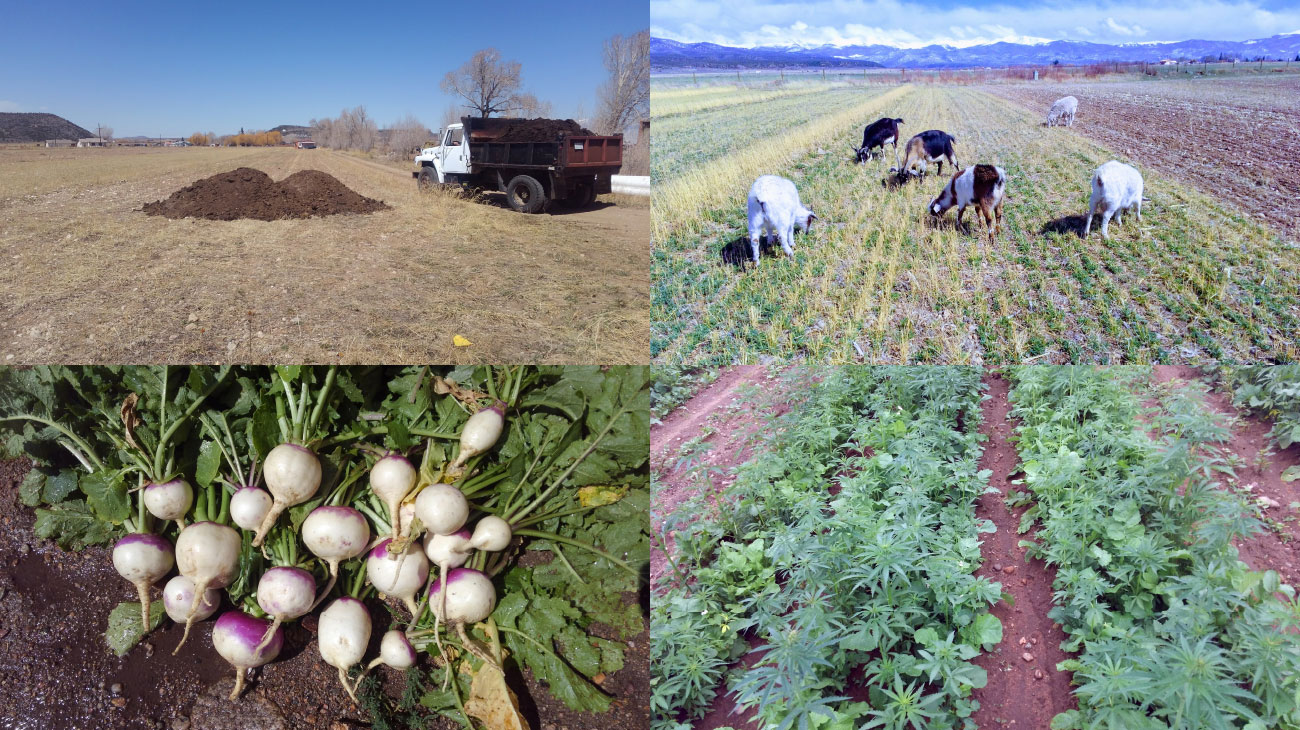
Arnie Valdez at Colorado’s Rezolana Institute explored opportunities in 2018 for integrating hemp with compost application, intercropping, and grazing and produced food, fiber, building materials, and agroecological services from a single field. (Photos by Arnie Valdez)
With these methods, a single field yielded food, hemp seeds for planting and eating, hemp fiber for textiles and cordage, hemp hurd for construction bricks, benefits for birds, forage for goats and sheep, and fertility and moisture retention for the soil. Such systems give a vision for what is possible when we engage mutually beneficial relationships on the farm. Establishing scalable and financially viable systems that support such relationships is another important step toward achieving the full potential offered by hemp.
“It’s not the hemp it’s the how.”
Many people now share excitement about the opportunities offered by hemp. The plant is certainly useful, yet it is also very new to most of us in the United States, and we are still getting to know the plant. As people make claims about hemp, we need to continue grounding our understanding in direct experience and by partnering with others with that experience, for example in the international community.
Hemp is nothing more and nothing less than a plant, with all the limitations and magnificent qualities that entails. As a plant, hemp is self-assembling, reproducing, evolving, and fueled by air, water, and sunlight. It is certainly magical, but it is not—as some present it—a magic bullet.
Claiming that any one plant will “save the world” without us as humans changing how we relate to our home and environment is simply inaccurate. We do the plant and our efforts a disservice by setting up unreasonable expectations.
Responsibly accessing the power of hemp and that of other of plants requires, among other things, approaches that are place-based, nuanced, and systemic. In our efforts to heal our landscapes, it’s not the hemp that is going to help, it’s how we relate to it and other plants and animals and how we invite them into an integrated system, largely defined by the cycles of place from soil to clothing and back to soil again.
It’s not the hemp, it’s the how.
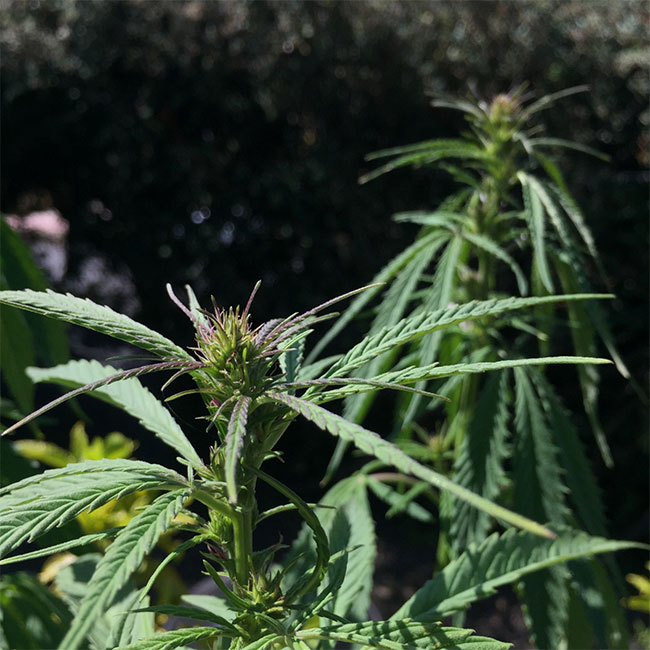
For example, we might:
- Shift how we relate to the plants and the soil, guided by current agroecological knowledge as well as further research.
- Develop plant breeds appropriate to place and to application.
- Ground our understanding with direct experience and with direct relationships to producers.
- Establish regulatory frameworks that support farmers and processors by putting hemp on equal standing with other fiber crops in the commodity market.
- Integrate hemp with existing textile systems, such as those for cotton and wool, and look for creative synergies. For example, how could co-locating a hemp degumming facility with a dye house or a wool scouring facility help us meet multiple needs with shared infrastructure?
- Utilize international partnerships to develop local solutions for degumming and spinning.
- Consider all bast fibers—including flax, nettle, and dogbane—and choose those that are most appropriate to application and place.
- Shift how we relate to what we make, deepening our relationships with our textiles and increasing their care and useful lives.





